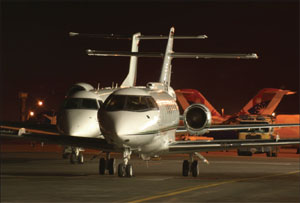
Features
Operations
Cost Containment for Premium Charter Operators
October 1, 2007 By René Armas Maes
 Business aviation worldwide continues to grow due to the airlines’
Business aviation worldwide continues to grow due to the airlines’
inefficient hub-and-spoke system, tightened security measures at
airports and the productivity gains accomplished through more efficient
point-to-point services for executives. Premium charter operators
continue to develop tailor-made products and services to fill market
niches, broaden their customer base and maximize earning power. But
cost containment strategies are paramount to ensure business longevity,
adequate financial return on investment and the funds for further
expansion.
This
discussion focuses on a number of cost-cutting measures that premium
charter operators should reflect on for long-term survival in today’s
fiercely competitive environment while delivering value to stakeholders.
Consider
developing an evaluation framework that covers your company’s business
lines (aircraft management, ad hoc charter, FBO services, maintenance,
etc.). Crafting a methodology to review your operational costs will
allow you to stay focused while ascertaining and further investigating
operational cost developments and trends (see figure 1). An initial
cost assessment process should include the following areas:
Financials
Complete
a detailed historical operational cost review to identify trends and
deviations from budgeted numbers and discern fastest-growing
operational cost items that will need further individual assessment.
This should be carried out in constant dollars to provide real
inflation-adjusted numbers instead of nominal ones.
Look for
trends and assess cost deterioration and improvements and identify your
organization’s strengths and weaknesses. Develop and conduct root-cause
analyses that will provide essential feedback to the overall
cost-cutting plan.
Careful attention should be taken when
comparing costs among a mixture of business lines. Assure proper cost
allocation to the right business line. Consider assessing as well a
number of other financial-related tasks to improve the following areas:
cash flow management and working capital techniques, account
receivables collection, cash and short-term investment management,
zero-bad-debt policies, debtors’ management, etc. Establish efficient
follow-up and monitoring systems that will allow you to effectively
control critical areas such as revenue collection, especially as
outstanding amounts become unmanageable.
Fuel price
Traditionally,
business aviation operators have taken advantage of fuel tankering and
bulk purchase initiatives to negotiate fuel prices with vendors. Take
the time to review your exclusive fuel supply contract and benchmark
against other suppliers. Be proactive and renegotiate based on future
expected operational levels both for charter and aircraft management
operations. Would it be possible to negotiate prorated fuel prices
after meeting and exceeding predetermined fuel volume levels?
Typically,
the fuel component of a particular corporate aircraft’s Direct
Operating Costs (DOC) has remained on average 53% of total DOC (see
figure 2). With fuel costs expected to remain high this year, a fuel
strategy is of prime importance for premium charter operators to
contain this cost. Shouldn’t you think about a more proactive and
hands-on way of reducing fuel costs?
Any fuel cost-cutting
policy should be a team effort. Involve pilots and mechanics in this
exercise. Keeping safety in mind, consider how to improve your flight
operations. Standard Operating Procedures and techniques should be
reviewed to ascertain whether improved cockpit and flight planning
management concepts could save fuel. Consider improvements in routing,
before-engine-start procedures, flight level decision making, taxiing
procedures, and compliance with Original Equipment Manufacturer
recommended cruise speed that will save on fuel and engine wear as well.
Evaluate
as well airframe upgrades such as winglets, especially for older
aircraft. They might help you to save on fuel and improve climb
performance while adding range. As upgrades are costly, weigh benefits
versus costs and assess the timeline for those upgrades to compensate
for their costs.
Fleet planning
A thorough fleet planning
methodology is paramount to select the best value-generating aircraft
candidate. Robust aircraft acquisition and replacement models are
important to maximize revenues and reduce costs. Consider looking at
residual values in your fleet planning model. Operators seldom conduct
analysis of what is perceived most of the time as the single greatest
cost of operating an aircraft type. Poor residual value recovery is a
cost that will impact your company’s future working capital. Predicting
residual value of business aircraft is difficult as it depends on a
number of factors such as market conditions at sale, inflation and
economic conditions. However, one can look at historical data and use
it as an indication of what can be expected in the future. Some
aircraft, as we know, retain their value better than others due to the
aircraft manufacturer’s brand name, dispatch reliability, safety, etc.
Typically, residual values and maintenance cost guarantees can also be
negotiated for new aircraft purchases particularly for the first five
years.
As aircraft age, you can expect reduced aircraft
availability due to increased maintenance needs, and perhaps parts will
become less available and therefore more expensive. Not only will this
increase your maintenance cost but also as the aircraft becomes less
available, its DOC will increase. New regulations and technology
related to new equipment and avionics can make it more effective to
replace your aircraft than to upgrade it. Consider these inputs to
build detailed cost/benefit analyses…